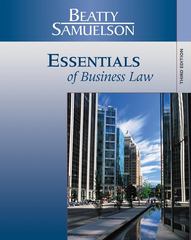Question
Principles of Microeconomics Assignment 1) Give three examples of price discrimination. For each case, explain why the firm chooses to follow this strategy. 2) What
Principles of Microeconomics Assignment
1) Give three examples of price discrimination. For each case, explain why the firm chooses to follow this strategy.
2) What are the main characteristics of a competitive market? Give two examples of government-created monopolies. Is creating a monopoly necessarily bad public policy in these cases; why or why not?
3) A publisher faces the following demand schedule for the next novel in a series.
Price Quantity Demanded
$100 0
90 100,000
80 200,000
70 300,000
60 400,000
50 500,000
40 600,000
30 700,000
20 800,000
10 900,000
0 1,000,000
The author is paid $1 million to write the book and the marginal cost of publishing a book is constant and $10 per book.
a) Add columns to the table above and compute the total revenue for each price and marginal revenue. At what quantity and price does marginal revenue equal marginal cost? How does
Does marginal cost compare to the price?
b) Add columns to the table above and compute the fixed costs, variable cost, total cost, and profit. What quantity and price result in the highest profit level?
c) Graph the demand, marginal revenue, and marginal cost curves. Label each curve as well
as each axis.
d) Suppose the publisher was concerned with maximizing economic efficiency rather than profits. What price would if a charge for the book? How much profit would it make at this
price?
e) If the author were paid $2 million rather than $1 million, would this affect the publisher's decision regarding what price to charge? Why or why not?
f) Calculate the deadweight loss that results in this market.
4) The residents of a small hub city all love historical folklore and propose creating a museum. The museum has a fixed cost of $4,800,000 and no variable costs. There are 200,000 residents in the town, and each has the same demand for museum visits QD = 10 - P, where P is the price for admission and Q is the number of visits.
a) Graph the museum's average total cost curve and its marginal cost curve. What kind of
does the market describe the museum?
b) The mayor proposes financing the museum with a lump-sum tax of $24 on each resident and then opening the museum to the public for free. How many times would each person visit? Calculate the benefit to each person with this proposal (calculated as the consumer
surplus minus the tax).
c) The city opposes taxes and requires the museum to charge an admission fee. What is the lowest price the museum can charge without incurring a loss? (Hint: Find the number of
visits and profit for each price, $2, $3, $4, and $5.)
d) For the break-even price that you calculated in part c, calculate the consumer surplus for each person.
e) What real-world considerations absent in the problem might provide a reason to favor an admission fee?
f) Compare the two proposals (tax versus admission fee), who is better off with the fee and
who is worse off?
Step by Step Solution
There are 3 Steps involved in it
Step: 1

Get Instant Access to Expert-Tailored Solutions
See step-by-step solutions with expert insights and AI powered tools for academic success
Step: 2

Step: 3

Ace Your Homework with AI
Get the answers you need in no time with our AI-driven, step-by-step assistance
Get Started


